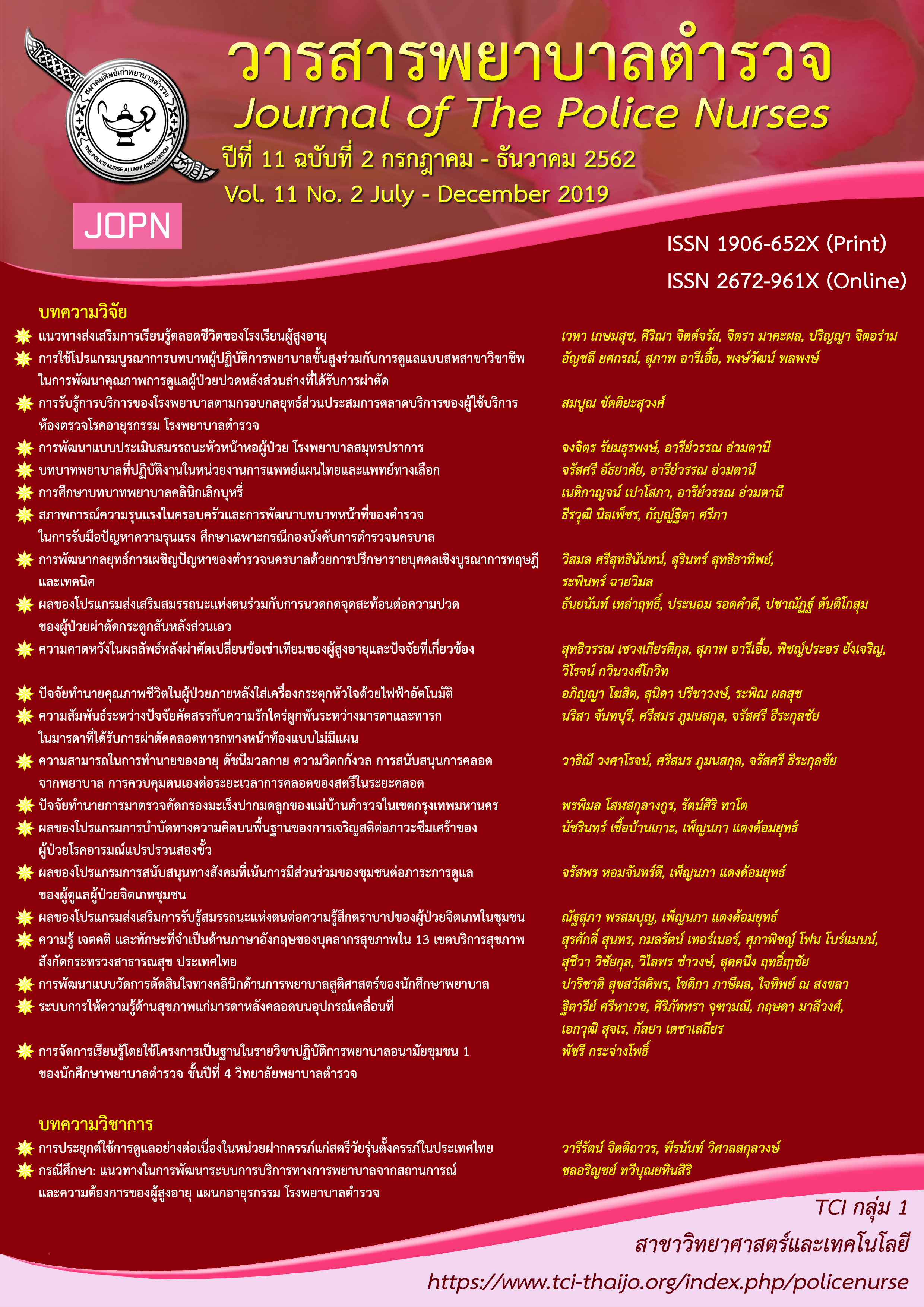PREDICTING QUALITY OF LIFE AMONG PERSONS WITH AUTOMATIC IMPLANTABLE CARDIOVERTER DEFIBRILLATOR
Keywords:
Quality of life, Automatic implantable cardioverter defibrillator, Uncertainty in illnessAbstract
A study was conducted to examine whether the potential factors could predict quality of life among persons with automatic implantable cardioverter defibrillator. One hundred and twenty samples with automatic implantable cardioverter defibrillators were recruited from super-tertiary hospital in Bangkok. The research instruments included 1) demographic data 2) frequency of automatic implantable cardioverter defibrillator shock questionnaire 3) multidimensional scale of perceived social support Thai version 4) Mishel uncertainty in illness scale-community version Thai version 5) knowledge of automatic implantable cardioverter defibrillator test 6) EQ-5D-5L. All research instruments were tested for content validity and reliability. Cronbach’s alpha coefficients were .91, .90, .78 and .81, respectively. Data were analyzed using multiple linear regression.
The results were as follows: The majority of subjects (75%) were male; average age was 51.50 years. The mean score of Quality of life was high (M=.86, SD=.17). Only two variables were significant predictors. Uncertainty of illness had significant negatively related with quality of life (Beta=-.327, p=.001). Frequency of AICD shock was negatively correlated with quality of life (Beta=-.248, p=.005). These two variables accounted for 24.7% of the explained variation in quality of life at statistical significance of p<.05 (F (4,119)=9.455, p=.000, R=.497, R2=.247, R2Adjusted=.221).
Downloads
References
American Heart Association. (2017). CPR & first aid emergency cardiovascular care. Retrieved from https://cpr.heart.org/AHAECC/CPRAnd ECC/General/UCM_477263_Cardiac-Arrest-Statistics.jsp
Cardiovascular & Metablobic Center Ramathibodi Hospital, Faculty of Medicine Ramathibodi Hospital, Mahidol University. (2016). AICD insertion statistics. Unpublished raw data.
Dickerson, S. S., Kennedy, M., Wu, Y. W., Underhill, M., & Othman, A. (2010). Factors related to quality of life pattern changes in recipients of implantable defibrillators. Heart and Lung, 39, 466 – 476.
Dillman, A.D. (2000). Mail and internet survey: The tailored design method. New York, NY: Weley-Interscience.
Eastwood, J., Doering, L., Robper, J., & Hays, R. D. (2008). Uncertainty and health- related quality of life 1 year after Coronary angiogram. American journal of Critical care, 17(3), 232-242.
Flemme. I., Edvardsson, N., Hinic, H., Jinhage, B. M., Dalman, M., & Fridlund, B. (2005). Long-term quality of life and uncertainty in patients living with an implantable cardioverter defibrillator. Heart & Lung, 34, 386-92.
Flemme, I., Hallberg, U., Johansson, I., & Stromberg, A. (2011). Uncertainty is a major concern for patients with implantable cardioverter defibrillators. Heart & Lung, 40(5), 420-428.
Friedmann, E., Thomas, S. A., Inguito, P., Kao, C. W., Metcalf, M., Kelley, F. J., . . . Gottlieb, S. S. (2006). Quality of life and psycho-logical status of patients with implant-able cardioverter defibrillators. Journal of Interventional Cardiac Electrophysiology ,17, 65–72.
Gopinathannair, R., Lerew, D. R., Cross, N. J., Sears, S. F., Brown, S., & Olshansky, B. (2017). Longitudinal changes in quality of life following ICD implant and the impact of age, gender, and ICD shocks: Observations from the INTRINSIC RV trial. Journal of interventional cardiac electrophysiology, 48 (3), 291-298. doi: 10.1007/s10840-017-0233-y.
Hersi, A. S., Alhabib, K. F., AlFaleh, H. F., AlNemer, K., AlSaif, S., Taraben, A., . . . Al-Muraye, M. A. (2012). Incidence of ventricular arrhythmia and associated patient outcomes in hospitalized acute coronary syndrome patients in Saudi Arabia: Findings from the registry of the Saudi project for assessment of acute coronary syndrome (SPACE). Annals of Saudi Medicine, 372-377. doi:10.5144/0256-4947.2012.372.
Humphreys, N. K., Lowe, R., Rance, J., & Bennett, P. D. (2016). Living with an implantable cardioverter defibrillator: The patients experience. Heart & Lung, 45, 34-40.
Irvine, J., Dorian, P., Baker, B., O'Brien, B. J., Roberts, R., Gent, M., . . . Conolly, S. J. (2002). Quality of life in the Canadian implantable defibrillator study (CIDS). American Heart Journal, 144, 82–289.
Kamphuis, H. C., de Leeuw, J. R., Derksen, R., Hauer, R. N., & Winnubst, J. A. (2003). Implantable cardioverter defibrillator recipients: Quality of life in recipients with and without ICD shock delivery: A prospective study. Europace, 5(4), 381-389.
Morken, I. M., Isaksen, K., Karlsen, B., Norekval, T. M., Bru, E., & Larsen, A. I. (2012). Shock anxiety among implantable cardioverter defibrillator recipients with recent tachycardia. Pace, 35, 1369-1376.
Mishel, M. H. (1988). Uncertainty in illness. journal of Nursing Scholarship, 20(4), 225-232.
Mishel, M. H. (1990). Reconceptualization of the uncertainty in illness theory. Journal of Nursing Scholarship, 22(4), 256-260.
Mishel, M. H., & Clayton, M. F. (2003). Theory of uncertainty in illness. New York, NY: Springer Publishing.
Passman, R., Subacius, H., Ruo, B., Schaechter, A., Howard, A., Sears, S. F., . . . Kadish, A. (2007). Implantable cardioverter defibrillators and quality of life results from the defibrillators in nonischemic cardiomyopathy treatment evaluation study. Archives of Internal Medicine, 167(20), 2226-2232.
Pattanaphesaj, J. (2014). Health-related quality of life measure (EQ-5D-5L): Measurement property testing and its preference-based score in Thai population (Doctor of philosophy, Pharmacy administration). Faculty of Graduate Studies, Mahidol University, Nakornpathom.
Pedersen, S. S., Theuns, D. A. M. J., Muskens-Heemskerk, A., Erdman, R. A. M., & Jordaens, L. (2007).Type-D personality but not implantable cardioverter-defibrillator indication is associated with impaired health-related quality of life 3 months post implantation. Europace, 9, 675-680.
Pedersen, S. S., Spek, V., Theuns, D. A., Alings, M., van der Voort, P., Jordaens, L., . . . Cuijpers, P. (2009). Rationale and design of WEBCARE: A randomized, controlled, web-based behavioral intervention trial in cardioverter-defibrillator patients to reduce anxiety and device concerns and enhance quality of life. Journal of Cardiovascular Nursing, 24(3), 225-231
Peky, K. Y., Lim, Y. Z., Hopper, I., & Krum, H. (2014). Medical therapy versus implantable cardioverter-defibrillator in preventing sudden cardiac death in patients with left ventricular systolic dysfunction and heart failure: meta-analysis of > 35,000 patients. International Journal of Cardiology, 73(2), 197-203.
Sears, S. F., Matchett, M., & Conti, J. B. (2009). Effective management of ICD patient psychosocial issues and patient critical events. Journal of Cardiovascular Electrophysiology, 20(11), 1297–1304.
Steinberg, B. A., Al-kathib, S. M., Edward, R., Han, J., Bardy, G. H., Biger, T., Buxton, A. E., . . . Sander, G. D. (2014). Outcome of implantable cardioverter defibrillator use in patients with comorbidities. JACC: Heart Failure, 2(6), 623-629.
Somjaiwong, B. (2010). The influence of symptoms, social support, uncertainty, and coping on health-related quality of life among cholangiocarcinoma patients (Doctor of philosophy, nursing science). Faculty of Nursing, Chulalongkorn University, Bangkok, Pathumwan.
Suwanpasak, A., & Boonyapisit, W. (2014). The quality of life in implantable cardioverter defibrillator patients. Journal of The Medical Association of Thailand. March, 97(3), S108-S114.
Suyama-Chishaki, A., Miyazono, M., Tsuchihashi-Makaya, M., Chishaki, H., Inoue, S., Mukai, Y., . . . Kubo, C. (2007). Quality of life and psychological factors in patients with implantable cardioverter defibrillator. Journal Arrythmia, 23(4), 269-276.
Velara, C., Daniela, G. M., & Lara, G. (2014). Quality of life and uncertainty in illness for chronic patients. Mediterranean Journal of clinical Psychology, 2(2). doi: https://dx.doi.org/10.6092/2282-1619/2014.2.990.
Wong, F. M., Sit, J. W. H., & Choi, K. C. (2014). Factors associated with health-related quality of life among patients with implantable cardioverter defibrillator: Identification of foci for nursing intervention. Journal of Advanced Nursing. 22(3), 821 - 834.
Zayac, S., & Finch, N. (2009). Recipients of implanted cardioverter-defibrillators actual and perceived: A review of the literature. Journal of American Academy of Nurse Practitioners, 21, 549-556.
Downloads
Published
How to Cite
Issue
Section
License
ผลงานที่ได้ตีพิมพ์แล้วจะเป็นลิขสิทธิ์ของวารสารพยาบาลตำรวจ















